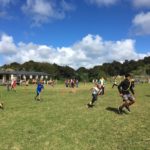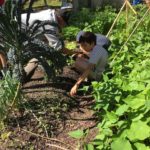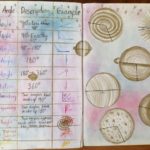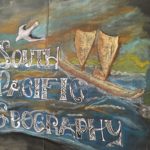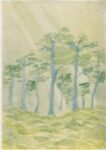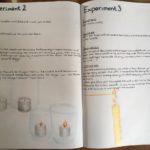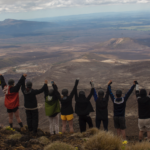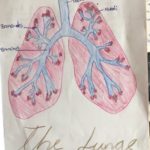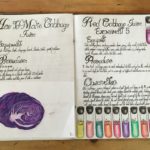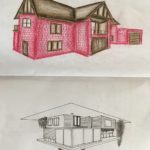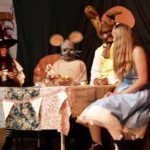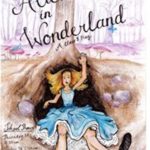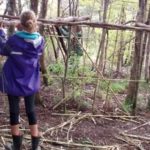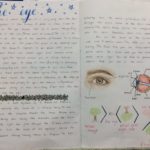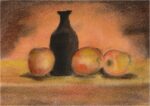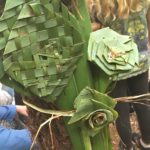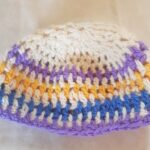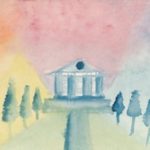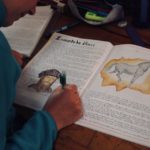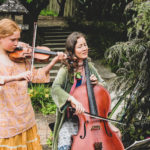In Middle School our teachers guide students on a journey to become practical and freely creative in their thinking, have the courage to carry out their aspirations, and be flexible and adaptable in order to meet the challenges of the world.
Middle School can be compared with intermediate schools, and offers a seamless transition from the Lower School, into our Upper School (high school). Building on the strong fundamentals created during Lower School, students continue their learning in the familiarity of the same class and with the same teacher still, ensuring stability and strength of class community.
“A human being can only come to an experience of freedom if his intellectuality awakens within him of itself, not if it is poured into him by his teachers.” Rudolf Steiner
- Classes 6-8, with students aged 11-14
- Their trusted teacher stays with them throughout this next step in their journey, with increasing input from Upper School teachers in some lessons
- Class size is up to 25 students
- Minimal assessment or testing
- Te Reo and Te Ao Māori are integrated throughout the curriculum in each class
- The curriculum includes all subjects taught in intermediate schools such as english, mathematics, science, geography and history, progressing according to the developmental stages of the students.
To view our latest Education Review Office (ERO) Report please click here
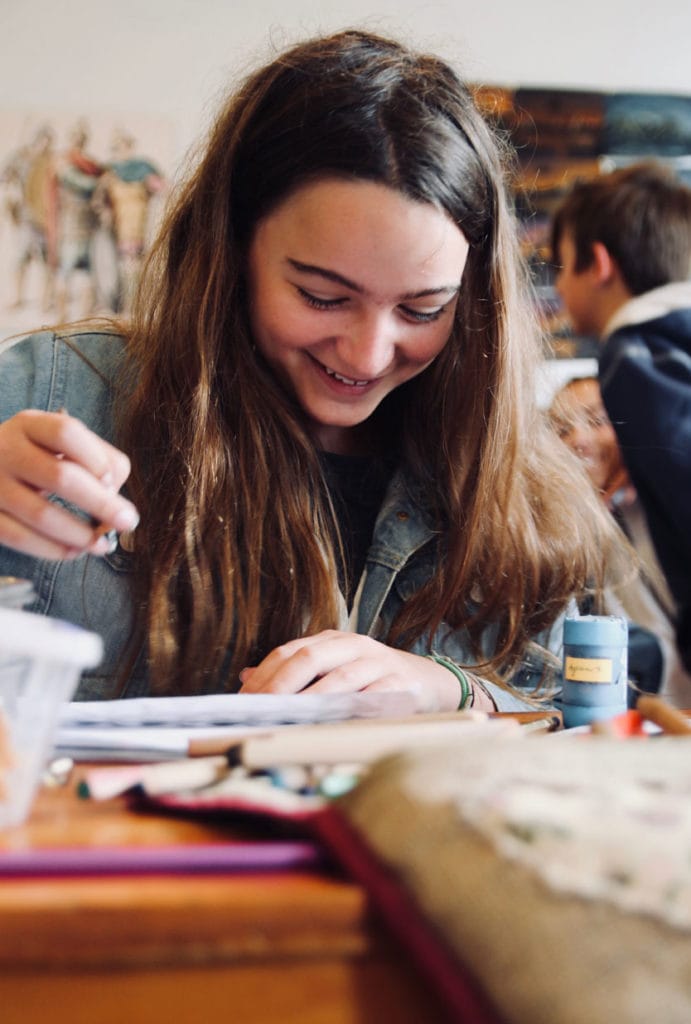
Class Six - “How I stand in the world”
- Children start Class Six in the year they turn twelve.
- The theme of the year moves from Greek times into Roman times
- Increased student interest in the world is extended to include ecological awareness and respect for different cultures.
Children turning 12 have arrived at the age of consequences. For the first time we can reason with them. They can begin practising self-control and begin to imagine the outcomes of deeds or behaviour in the home, classroom and society.
Children in Class 6 go on a longer camp in which they meet the broader landscape, geology and the night skies, all of which inspire them to balance the more factual with the poetic. At a time where the students are feeling uncomfortable and unsure in their bodies, and can often tend to be lethargic, learning experiences are offered where the students are engaged through physical activity.
What is part of Class 6 curriculum?
English
Students are encouraged to experience the complexity of language and the need to be clear in speaking and writing. The beauty of language must also be experienced consciously by the students and they are encouraged to become familiar with and use expressive language in speaking and writing. Finding the right word to express a thought or feeling can be encouraged and this must always have its genesis in the student’s actual experience.
Mathematics
The content of the lessons should satisfy the students’ increased interest in the workings of the modern world and lead them to a meaningful world picture. Mathematical processes instil confidence in following a rule or process to achieve a desired outcome. An inner relationship begins to be developed to the logic, form and structure of Mathematics. There is a shift in the study of Mathematics from arithmetic and simple calculations to the appreciation of patterns and relationships. Students are given more responsibility for their own learning through direct practical experiences.
Class 6 seeks to bring to the children real, meaningful and practical experiences that satisfy their increasing interest in matters of the world. The content will give the students an understanding of the functioning of the world of economy, trade and banking, and instil good financial habits that will stand them in good stead for their adult lives.
History
Imaginative pictures continue to inspire the students, but like the Ancient Roman our 12 year old now stands solidly upon the earth. The students crave facts and understanding of their relationship to one another. Standing as they do on the uncertain threshold of a new phase of development the students find a sense of security and clarity through pursuing historical questions of causality. Students are given opportunities to exercise their ability to perceive and articulate different sides of an argument. They are encouraged to enquire and reflect before forming an opinion.
Class 6 historical studies work with the child’s need to experience the practical, imaginative and intellectual. Intellectual investigations of historical themes are balanced by creative, practical and physical explorations: movement, theatre, role-play, excursions and camps. Historical studies are integrated with english, the arts, geography and science.
Geography
Class Six looks beyond New Zealand to the Pacific and Australia.The Ring of Fire is identified and the student are made aware, though identifying the sites of volcanic activity and through story, of the special nature of this region of the earth. The three major areas of Polynesia, Melanesia and Micronesia are identified and studied. Through this investigation of the cultural, spiritual and economic life the students awaken an appreciation of the values, culture and experience of the peoples of the Pacific.
Having made a study of the animal world in Class 4, and the plant world in Class 5, the world of rocks and minerals is a topic for Class 6. The focus is not so much on geology per se, but on the formation of rocks and minerals and their qualities. In making this topic more concrete for them, Class 6 go to Waitomo on their camp and explore the limestone landscape with its spectacular caves and their amazing stalagmite and stalactite formations.
Science
Science as a discipline in its own right is only introduced in Class 6 when a phenomenological approach to physics looks at the phenomena associated with heat, light and sound as they are experienced by the human being. A study of magnetism and static electricity can also be undertaken (at a time of year when the air is dry). The focus is on the task of exact observation – the basis of scientific research. Experiments are carried out, observed and described with accuracy. Only then can questions be asked, discussion ensue, and possible conclusions as to what has happened, be drawn.
Te Reo and Te Ao Māori
Te Reo and Te Ao Māori are integrated throughout the curriculum. Some subjects will be chosen to delve more deeply. For example, geometry may be chosen where students learn shapes and colours and related phrases in Te Reo.
Handwork
In Class 6 handwork supports the experience of 3D and the content is chosen to support this. Animals make for a good choice of project for this. To simply cut out the silhouette shape of the animal is not enough. The ‘penny drops’ for some when they realise that to do so would result in a two legged animal. The projects at Class 6 involve complex instructions and the opportunity to reflect on the consequences of lack of attention earlier in the project. This is an aim of Class Six, as their capacity to comprehend the consequence of their actions in hindsight becomes available to them at this time.
The Arts
The arts are part of every lesson. The students are being taught though example that everyone can be an artist and that beauty is all around us. Movement, music and speech are included as part of every day’s activities and drawing and painting are continuously developed in harmony with the student’s inner growth.
Camp
Children in Class 6 go on a longer camp in which they meet the broader landscape, geology and the night skies all of which inspire them to balance the more factual with the poetic. This camp is often to the geologically incredible Waitomo caves.
The students begin to find their voice and to have available the techniques to express this voice with power and subtlety.
Class Seven - “What will I carry into the world?”
- Children start Class Seven in the year they turn 13
- The theme of the year is the Renaissance and the Age of Discovery
- Increased student interest in the world is extended to include ecological awareness and respect for different cultures.
In Class Seven, the students reach 13 years of age and become teenagers. Puberty arrives and students no longer experience themselves as children. They may resent school and parental rules, would like to be independent, but do not yet have the ability to strike out on their own.
This is the final stage of the second seven year phase, during which we witness the birth of the rational intellect out of the rich imaginative life of feeling. Conceptual thinking starts to come to the fore, and the student begins to develop critical abilities. Students are eager to expand their knowledge of the wider world.
Rudolf Steiner described this stage as the development of ‘earth’ maturity, meaning that the students now fully engage with the wider outer world, while developing personal, individualised judgements about the truth. Students are encouraged to take initiatives and to challenge attitudes and knowledge which they formerly accepted on authority and in this way to formulate their own point of view. In the striving for individuality, students are encouraged to accept that others see the world differently.
What is part of Class 7 curriculum?
English
The ability to immerse oneself in the life of others, to empathise and to care are paramount to both the individual’s development and that of the world. The students are able to enter worlds otherwise unavailable to modern experience and their voice is enriched by the voice of the great men and women of history
Given the fluctuating mood swings of students of this age it is appropriate to study the influence of mood on writing styles and to extend the investigation to include a study of poetics and metrics in general. The ‘Wish, Wonder and Surprise’ Main Lesson effectively meets these learning objectives.
This creative writing theme encompasses the three soul moods of Wish (born in the ideal of the thinking but not mere fantasy), Wonder (of the feeling life in relation to the world – not escapism) and Surprise (the world brings a reaction of whole body experience which does not become rampant consumerism). These are represented by Wish – expansive, dreamy; Wonder – lots of adjectives, adverbs and metaphors and Surprise – short, quick sentences full of tension and release.
Mathematics
There is a continued need for the presentation of clear concepts grounded in practical applications in the outer world. Once the students display solid foundations in the logic, form and structure of Mathematics, they may be led towards increasingly intellectual and abstract concepts. Algebra develops out of the practical use of formulae, and students begin to discover its power as a method of describing problems, patterns and forms.
The introduction of Algebra represents a major conceptual leap for the students. While the concrete, logical rules and processes bring the children very much into their thinking realm, their new-found logical reasoning skills are applied to the representation of the concrete with the abstract. The rules and processes of Algebra are developed out of working with simple formulae and the use of pronumerals, brackets and negative numbers in equations as a technique for solving practical problems. During this topic, the aims are to engender in the students an appreciation of how general rules of arithmetic become clear through algebra, and to enable them to grasp the principle of balance in an equation.
Science
Subjects that have been introduced in the previous year are revisited but now at a deeper level. Now the phenomena can be focussed on in their causative relationship – the trend is towards the mechanical. Acoustics is now approached from the relationship between tone and vibration. Optics is deepened now with those images which lend themselves to mechanical manipulation – the mirror and the pinhole camera. Warmth is approached now from the point of view of expansion and contraction which leads to temperature measurement.
Chemistry lessons are taught as an experience of process. So we begin with fire (embodied process). It can’t be lifted up and put in your pocket. It lacks ‘thing’ nature. It is dynamic and transforming. Substances disappear and new ones appear within an ordered process which engages the surroundings intensely. The well known chemical substances – acids and bases emerge from the fire. The fire process takes us on a journey from the burning of plant material, to the calcining of limestone (a mineral) derived from the animal world, to metals which burn without smoke and only give us ash (ore) and finally sulphur which burns to give only acid smoke but no ash.
Chemistry taught as process (rather than with abstract intellectual models) allows the young person to engage with important phenomena and to be able to understand them out of the qualitative experience. This provides motivation and interest in a subject which is important to understand when attempting to understand environmental issues where chemistry is embedded in life processes.
The Health and Nutrition main lesson comes at an important stage in the student’s physical development as the onset of puberty brings a new awareness of the body’s existence. The main lesson looks in depth at the physical makeup of the human being and the student’s growth so far. An infant can hopefully be brought into class and observation made about the changes that have occurred since that new born state. Male and female differences are now becoming more apparent and are acknowledged in an introductory study of sexuality. The functioning of the heart and the lungs in maintaining life can be studied The importance of good hygiene and nutrition is emphasised.
History
The students are increasingly given opportunities to exercise the faculty for independent thought. They are encouraged to make accurate observations and to produce accurate historical narratives and reports. More challenging intellectual exploration of ideas is facilitated through the practical, artistic and imaginative elements of the lessons. Students are encouraged to identify and articulate a range of points of view, including their own. They are supported to develop the skills to effectively communicate their observations, ideas and opinions.
The history curriculum begins with the Age of Discovery, tracing the expansion of European knowledge of the globe as sea captains set out into the uncharted Atlantic, heading west to hopefully find India – but instead finding islands in the Carribean and later the Americas.
A connecting theme in the study of societies, through this and the following year, is the change in consciousness and the development of the idea of individuality as we experience it in the modern world.
The Renaissance is the leitmotif for experiences of the young adolescent. It is a period of new discoveries – both in the physical world and in realms of perception and thought. It marks the birth of modern history and individual consciousness and parallels the development of new capacities in the student. In this topic the students examine the origin and significance of the period and the expansion of intellectual, artistic and scientific horizons. The students study innovations in the world of music, art, science, and in political and religious life. The biographies of significant people are used to give the students a sense of the changes in social, political and economic worlds.
Towards the end of this period – and as a direct result of a new more intellectual understanding – the status of religious belief is called into question. In Northern Europe, free thinkers challenge the dogma and authority of the Roman Catholic church, leading to the Reformation and the foundation of Protestant Christianity.
Te Reo and Te Ao Māori
Te Reo and Te Ao Māori are integrated throughout the curriculum. Some subjects will be chosen to delve more deeply. For example, physiology may be chosen where students learn body parts, food and related phrases in Te Reo and the concept of hauora – wellbeing.
Handwork
Overall Class Seven handwork is a time to look back a little, to take some skill learned earlier and take it to another higher level. Thus crochet, knitting and embroidery can be revisited. As a result, there is always a variety of projects within the room. The pleasure and joy in each other’s projects continues to shine. Social enjoyment is an integral part of the handwork lessons.
Camp
To meet the theme of adventuring forth into new territory, Class 7 camp will be further afield and involve a journey such as canoeing down the Whanganui river, or hiking the Tongariro crossing.
Students continue to form strong connections to information through their feelings. The quality of imagination is still an important ingredient in their reception of intellectual material.
Class Eight
- Students start Class Eight in the year they turn 14
- This year forms a significant point in the transition from childhood to adolescence
As the critical faculties of students sharpen, the world of ideas acquires new meaning and rules come under scrutiny. Students like reasoning and are reasonable.
For students in this year, the physical and psychological changes of adolescence are well under way. They are often awkward in their own bodies and have sometimes lost the gracefulness of childhood. Acne, ‘gangliness’, clumsiness and a new vulnerable awareness of their feeling and thought life are some of the characteristics of the adolescent.
English
The Main Lesson study includes an overview of the development of language from song to speech to the written word. Students explore the way in which the qualitative nuances of the sounds of vowels and consonants and the varied rhythms of language usage influence the potential power of the ‘living word.’ They investigate the use of persuasive language in propaganda, speech making, advertising and other forms of mass media and consider the influence of different styles and forms of writing and speaking on the way we communicate with each other. Students are given opportunities to enjoy language, to be creative and to play with words.
Letters as a genre are fairly brief texts that are written in a wide variety of styles and the study of their form and content therefore offers students an encompassing theme and an appropriate means to explore and practise writing different text types. A familiarity with the conventions of various types of letters enables students to use this method of communication, formally and informally, with confidence. By studying letters of historical and literary significance, students gain an appreciation of the potential of letters to convey thoughts and feelings with clarity and eloquence.
Mathematics
The content of the lessons should empower students to feel at home in the modern world and lead them to bring all they have learnt into a meaningful world picture. At a time when the emotional life is changeable and turbulent, the students can be afforded a glimpse of a world of mathematical harmony, which reflects forms and laws that have been stable and unchanged for millennia. This offers an opportunity to rekindle a profound sense of awe at the perfection of these archetypal forms.
In this year we seek to bring to the students both a mathematical understanding and inner experiences in their relation to the world of cyclical change and rhythm. At a time where they are in danger of losing a reverent picture of the dynamic cosmos that they inhabit, the content of this topic serves to renew their sense of wonder at being part of something far larger and more meaningful than they perhaps realise.
The study of platonic solids seeks to bring to the students both a mathematical understanding and inner experiences in their relation to the Geometry of form. At a time where their bodies and emotional lives are undergoing significant change, it is supportive to encounter Mathematical laws that are established and timeless. An understanding of the historical significance of the Platonic Solids over millennia of human culture is both engaging and rewarding, and gives students an appreciation of the elegance, value and beauty intrinsic to mathematics.
The middle school years are an important period of learning, in which the foundations of knowledge of many fundamental disciplines are established. Algebra is a significant mathematical tool that finds application in the further study of mathematics, but also appears in the sciences, engineering, technology and economics, amongst others. A thorough grounding in Algebra is indispensable in many tertiary courses, and provides skills that create a pathway towards continued success in further education, training or employment.
Science
Topics studied include anatomy and physiology, organic chemistry, physics of air and water and electromagnetism.
With adolescence comes a much greater self consciousness of one’s own body. With the study of the human organs, the student has an opportunity to build a relationship with their own body as part of the world around them by making a study of those organs of the human body that clearly incorporate physical law.
The organic chemistry lesson picks up the threads of the Class 7 health, hygiene, nutrition and chemistry lessons by looking at the main food substances that we make use of – carbohydrates, proteins, and fats in nutrition. By studying the origins of these substances in their living form, and the means by which they are cultivated and harvested, an appreciation can be gained of the background to the quality of the substances which can then be experienced through the experiments and demonstrations in the classroom. The qualities of the substances are then related back to their role in the body’s formation. We start with the whole, work our way down to the parts, and then back up to the whole again.
The students will gain an appreciation of the main substances that build the bodies (plant, animal and human) of the world and how these substances are processed from their living origins into the food that make up the protein, fat and carbohydrate of our diet. This integrated knowledge builds an appreciation of the relationships between human life and the life of the world around us.
The lessons in electricity and magnetism from classes 6 and 7 come together into the technological triumph of far reaching consequences for the present – electromagnetism. To understand from the ground up the basis of much that goes on in the technology of today is an essential experience for the young adolescent. In understanding evermore deeply what is happening behind the technology enables them to feel at home in the world and feel able to make decisions that are founded in their own understanding. The idea is that one should understand and ‘see through’ technology to be able to partake in that world effectively and in freedom.
History
Topics studied include the Age of Revolutions and the Industrial Revolution.
The teacher endeavours to bring to life a kaleidoscope of events, personalities and influences and give students a sense of the multiple and intertwined causal factors and complex effects that are part of this turbulent time. Material is chosen which illuminates the perspectives of different individuals and groups. In studying the struggles for justice, equality and liberty the students engage with questions and concepts that meet their emotional and intellectual needs. The approach is symptomatic and thematic rather than a presentation of a linear chronology. Students examine social and political factors through the lens of differing human experiences. The Class 8 student looks to understand the world they live in. It is important that attention is paid to issues of their time. There is flexibility for any theme or issue from the topic to be followed through to the present.
The ability to consider a variety of perspectives prepares the student for life in a world characterised by cultural, social, religious and ethnic diversity.
Geography
The Age of Discovery main lesson in Class 7 brought a greater awareness of the location of the countries of the earth and the extent to which the oceans and seas cover the globe. In Class 8 a study can be made of any particular region or culture that might be of interest, be it Europe, North America, Africa, Russia. Possibly two regions could be contrasted, or students may pick their own area of interest and do research before presenting their findings to the class.
Handwork
Class Eight is a time when all are asked to work together to achieve a goal. That may be knitting bags for the incoming Class 1, designing and making costumes for their play, or, for example, making 100 reusable shopping bags for the community as undertaken by Class Eight 2018. Class Eight is the age when an underlying purpose of handwork begins to dawn on the young people, the ability to think practically, to problem solve, to be given a challenge and to find the best way to work together co-operatively to achieve a goal.
Drama
After several years of preparing for and presenting shorter class plays, students undertake a major dramatic performance that is a hallmark of the Class 8 year. Students take on responsibility to not only learn their individual lines and develop their acting skills, they also produce the play, create props and undertake all activities related to staging a play. The class teacher will act as a Director, but the class has to take the initiative for production.
Camp
Class 8 camp is both a celebration of the conclusion of Middle School and a rite of passage as the students embark on their Upper School journey. This will involve a physical and emotional challenge that builds social unity such as an expedition tramping in a national park.
The lessons support and encourage the students’ youthful idealism, provide them with inspiring role models and daily opportunities to form their own judgements about experiences they have gained from the lessons. It is important to bring a positive and engaging world picture to fourteen year olds, so that they might find a way to connect with the world and find a meaningful place within it.
Specialty subjects
Visual arts
Visual arts are integrated throughout the curriculum. The aim is to develop the artist within each child. We teach not just artistic skill, but all subjects are taught artistically. Throughout the lower and middle school years the visual arts are developed from simple watercolour painting to working with perspective through colour, beeswax modelling, and clay sculpting.
Music
Music is integrated throughout the curriculum. Developing the musician’s ear, is as important as learning to play music. Classes may join together to form a choir or musical ensemble for assemblies and festivals.
Woodwork
We have a wonderful woodwork studio in which students learn practical skills and the joy of creating beautiful objects from scratch.
Drama
Each class presents a play each year, with all students participating in a variety of roles over time to challenge them and widen their perspective of others. This culminates in a profession production at Class 8.
Eurythmy
Eurythmy is taught throughout the lower and middle school. Eurythmy builds spatial awareness in children and an expressive connection to their spirits. The eurythmy teacher calls the children to grace and beautiful movement through exercises, patterns and games with increasing complexity as the children grow. Students learn to comprehend their own movement in a disciplined way over time, and also the movements of others and the need for space to be maintained thoughtfully between people, not only for oneself. Eurythmy makes for intelligent feet and hands that inform an intelligent head and a thinking heart.
Handwork
Handwork develops from basic knitting, crochet and sewing to producing challenging and complicated handwork items. Handwork is more than making things, it can lay the foundation for work, give the children a sense of pride and a feeling of success; it can support the development of a sustained will and being able to apply oneself to complete a task. It can strengthen their life forces through applying thought and effort in making something which they have enthusiasm and joy in making. Through learning new skills their capacity to concentrate and focus is strengthened. Through following instructions, written and verbal, their comprehension of the word is supported. It gives the students experience of making whatever they choose to do into a practical reality.
The rhythm of the day
Morning circle
The day begins with a morning circle, an “in-breath” starting with a verse. Then games, songs and other movement activities follow, challenging the students to work together as well as having some fun! The morning circle practices many skills and brings the students into the rhythm of the day and a readiness to learn.
Main lesson
The main academic subjects are taught in the first two hours every morning for a period of three to four weeks. In this way the students are able to live deeply into a subject. Subjects are approached in an integrated and artistic way. The rhythm of this approach, the development, and depth of content gives the children a rich learning experience. The main lesson incorporates subjects such as English, mathematics, history, geography and science and technology. Students create their own beautiful main lesson books rather than learning from textbooks. Within the rhythm of the class day, this is considered to be the ‘thinking’ part of the day.
Encouraging and allowing children to learn experientially, avoiding sitting them down and feeding them facts, lies at the heart of every Waldorf teacher’s intent.
Practice lesson
After morning tea, during the practice lesson, students consolidate their main lesson learning, practise literacy and numeracy skills and participate in art, music, language and movement lessons. Within the rhythm of class day, this is considered to be the “feeling” part of the day.
Afternoon lesson
The afternoon lesson is the ‘willing’ or doing part of the day. Children take part in games and sports as well as participating in a range of creative and practical activities such as gardening and cooking.
Specialist teaching periods
Students learn from specialist teachers in areas such as handwork, eurythmy, bothmer gym, languages, music, and art. Students in Classes 6 – 8 have woodwork lessons and PE classes.
Festivals
Easter, Autumn, Mid-winter, Matariki, Spring, and Advent Festivals are celebrated throughout the year. In the week leading up to the festival students are led to a relationship with the event and the season through appropriate activities, stories, songs and verse. The festivals are celebrated annually allowing the students to build up a body of knowledge and enhancing their experience over time.
The students are encouraged to experience respect and reverence for the earth and life as a whole, through a rhythmical celebration of seasonal and traditional festivals throughout the course of the year. These festival days are celebrations which bring the whole community together and offer an opportunity for the teachers and children to engage in drama, artistic presentations, crafts and singing.




